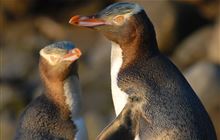Yellow-eyed penguin nest numbers down
Archived content: This media release was accurate on the date of publication.
Introduction
Recent yellow-eyed penguin/hoiho nest counts on mainland New Zealand indicate a continued decline in numbers in some areas for this rare taonga species says DOC Threatened Species Ambassador Nicola Toki.Date: 24 November 2017
DOC carries out monitoring, research, and intensive management for yellow-eyed penguins alongside Treaty Partner Ngāi Tahu, key programme partner the Yellow-eyed Penguin Trust, University of Otago, important local associates such as Penguin Place and Penguin Rescue, community groups and volunteers.
"Our work with yellow-eyed penguins stretches from sites on Banks Peninsula down to the subantarctic islands," says Ms Toki.
"While nest numbers are similar to last year from Dunedin northwards, there are declines further south. The estimate for the total southern east coast based on current counts is around 250 nests, down from 261 a year ago. This number is of concern given historically there were between 400-600 breeding pairs and the current number is the lowest for 27 years."
The decline is steepest on Codfish Island/Whenua Hou off the coast of Stewart Island/Rakiura where only 14 hoiho nests were found, down from 24 the previous year. Nest counts of yellow-eyed penguins on Whenua Hou have been steadily declining with a sharp decrease in the number of nests over the past couple of years. As Whenua Hou is a predator-free island with limited human access, terrestrial influences are unlikely to be the cause.
Yellow-eyed Penguin Trust General Manager Sue Murray says "the Trust has huge concerns for the future of hoiho on Whenua Hou given their rapid decline. Our focus must be the marine environment where hoiho spend at least half of their life as it is unlikely that terrestrial impacts are a major factor in the decline here. The Trust, DOC and Ngāi Tahu are working with urgency to address this situation."
Yellow-eyed penguins face wide-ranging threats from climate change to disease. Avian diphtheria remains a serious ongoing issue for the birds and can affect a large proportion the newly-hatched chicks.
More research is needed on the factors affecting the population of hoiho, particularly on Whenua Hou, and DOC is working with Ngāi Tahu and the Yellow-eyed Penguin Trust to develop a new recovery plan and strategy. This will refocus strategic priorities for the conservation of hoiho, incorporate Ngāi Tahu perspectives to provide guidance for management, update management coordination and enhance conservation efforts.
Priorities in responding to this decline in hoiho numbers include:
- ensuring the basic needs in terms of habitat and terrestrial predator control are maintained at priority mainland sites. This includes working with site managers to see that trapping follows current best practice
- monitoring priority habitats to check the health of hoiho during the breeding season
- supporting the work of MPI to improve practices for the inshore set net fishery through observer coverage
- responding to unwell or injured birds
- supporting research – in particular investigations into hoiho foraging in the marine environment.
"We ask that people help us to protect these vulnerable birds this summer by giving the birds plenty of space and quiet, respecting barriers and encouraging the same behaviour from others," says Ms Toki.
"Please call DOC's Hotline on 0800 DOC HOT (0800 362 468) if you come across yellow-eyed penguins and are concerned about their condition, describing as accurately as possible when and where the bird was found."
Contact
For media enquiries contact:
Email: media@doc.govt.nz
Sue Murray, General Manager, Yellow-eyed Penguin Trust
Mobile: +64 21 488 285

